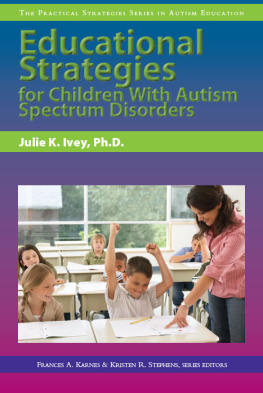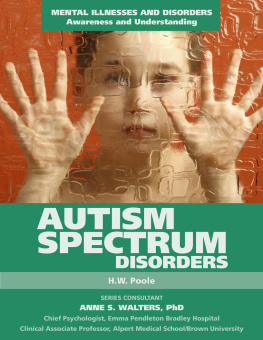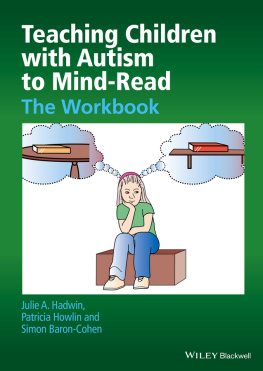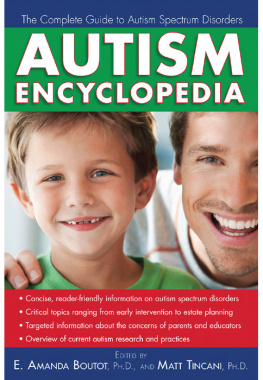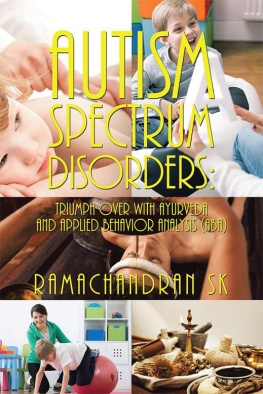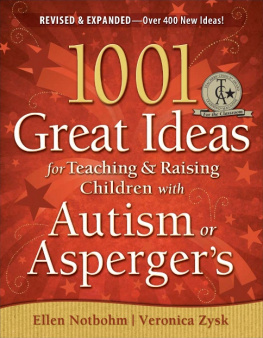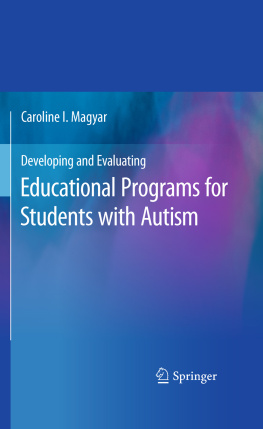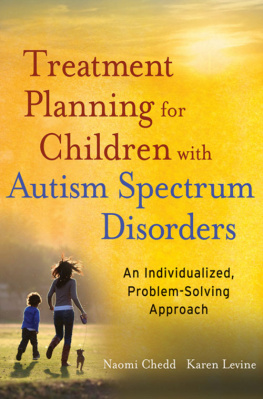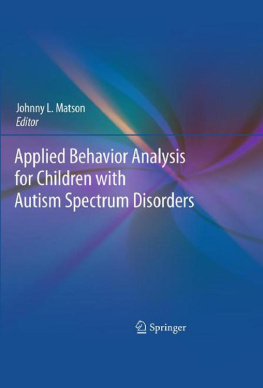Julie Ivey - Educational Strategies for Children with Autism Spectrum Disorders
Here you can read online Julie Ivey - Educational Strategies for Children with Autism Spectrum Disorders full text of the book (entire story) in english for free. Download pdf and epub, get meaning, cover and reviews about this ebook. year: 2009, publisher: Sourcebooks, Inc., genre: Children. Description of the work, (preface) as well as reviews are available. Best literature library LitArk.com created for fans of good reading and offers a wide selection of genres:
Romance novel
Science fiction
Adventure
Detective
Science
History
Home and family
Prose
Art
Politics
Computer
Non-fiction
Religion
Business
Children
Humor
Choose a favorite category and find really read worthwhile books. Enjoy immersion in the world of imagination, feel the emotions of the characters or learn something new for yourself, make an fascinating discovery.
- Book:Educational Strategies for Children with Autism Spectrum Disorders
- Author:
- Publisher:Sourcebooks, Inc.
- Genre:
- Year:2009
- Rating:3 / 5
- Favourites:Add to favourites
- Your mark:
- 60
- 1
- 2
- 3
- 4
- 5
Educational Strategies for Children with Autism Spectrum Disorders: summary, description and annotation
We offer to read an annotation, description, summary or preface (depends on what the author of the book "Educational Strategies for Children with Autism Spectrum Disorders" wrote himself). If you haven't found the necessary information about the book — write in the comments, we will try to find it.
Enhancing Communication in Children With Autism Spectrum Disorders presents an overview of impairments in communication among children with an ASD.
Julie Ivey: author's other books
Who wrote Educational Strategies for Children with Autism Spectrum Disorders? Find out the surname, the name of the author of the book and a list of all author's works by series.
Educational Strategies for Children with Autism Spectrum Disorders — read online for free the complete book (whole text) full work
Below is the text of the book, divided by pages. System saving the place of the last page read, allows you to conveniently read the book "Educational Strategies for Children with Autism Spectrum Disorders" online for free, without having to search again every time where you left off. Put a bookmark, and you can go to the page where you finished reading at any time.
Font size:
Interval:
Bookmark:
series editors
FRANCES A. KARNES & KRISTEN R. STEPHENS
for Children With Autism
Spectrum Disorders
Julie K. Ivey, Ph.D.

P RUFROCK P RESS I NC .
Copyright 2009 by Frances A. Karnes
and Kristen R. Stephens-Kozak
All rights reserved.
No part of this book may be reproduced, translated, stored in a retrieval system, or transmitted, in any form or by any means, electronic, mechanical, photocopying, microfilming, recording, or otherwise, without written permission from the publisher.
Printed in the United States of America.
ISBN-13:978-1-59363-782-8
At the time of this books publication, all facts and figures cited are the most current available. All telephone numbers, addresses, and Web site URLs are accurate and active. All publications, organizations, Web sites, and other resources exist as described in the book, and all have been verified. The author and Prufrock Press Inc. make no warranty or guarantee concerning the information and materials given out by organizations or content found at Web sites, and we are not responsible for any changes that occur after this books publication. If you find an error, please contact Prufrock Press Inc.
| Prufrock Press Inc. P.O. Box 8813 Waco, Texas 76714-8813 Phone: (800) 998-2208 Fax: (800) 240-0333 http://www.prufrock.com |
The Practical Strategies Series in Autism offers teachers, counselors, administrators, parents, and other interested parties up-to-date information on a variety of issues pertaining to the characteristics, diagnosis, treatment, and education of students with autism spectrum disorders. Each guide addresses a focused topic and is written by an individual with authority on the issue. Several guides have been published. Among the titles are:
- An Introduction to Children With Autism
- Diagnosis and Treatment of Children With Autism Spectrum Disorders
- Educational Strategies for Children With Autism Spectrum Disorders
For a current listing of available guides within the series, please contact Prufrock Press at 800-998-2208 or visit http://www.prufrock.com.
The word autism is derived from the Greek word autos meaning self. Although cases of autism spectrum disorders (ASD) had been documented in the 18th century, Dr. Leo Kanner (1943) and Dr. Hans Asperger (1944/1991), independently of one another, were the first to systematically study the disorder in the 1940s. Today, autism and Aspergers syndrome have been combined with other disorders to fall under the continuum of autism spectrum disorders. This spectrum includes Autistic Disorder, Aspergers syndrome, Childhood Disintegrative Disorder, Retts Disorder, and Pervasive Development Disorder-Not Otherwise Specified (PDD-NOS). Individuals with ASD exhibit a continuum of severity, ranging from mild to severe. In accordance with Drs. Kanner and Asperger, the current definition of an Autistic Disorder from the Diagnostic and Statistical Manual for Mental Disorders: Fourth Edition (DSM-IV; American Psychological Association, 1994) is (1) a qualitative impairment in social interaction; (2) a qualitative impairment in communication; and (3) restricted, repetitive, and stereotyped patterns of behavior, interests, and activities. These three impairments are often referred to as the triad or triangle of autistic disorders.
The impairment in social interactions can be seen by a lack of nonverbal behaviors such as eye contact, facial expressions, body postures, and typical social gestures. This impairment also is seen as an inability to form social relationships with peers and a seemingly lack of empathy. It is not that a child with autism does not care; it is that he or she has difficulty interpreting the perspectives of others. The impairment in communication skills can manifest itself from a total lack of verbal language to some simple word usage but with an inability to initiate or continue a conversation. A lack of imaginary or imitative play also is part of the communication impairment point of the autism triangle. Finally, the restricted, repetitive, and stereotyped behaviors appear as preoccupation of particular interests, inflexibility of transitioning to new activities or routines, and/or repetitive motor movements. Although not considered one of the points of the autism triangle, sensory or perceptual misrepresentations often accompany children with autism. This could include difficulties with certain sounds, tastes, touch, and the like.
According to the Centers for Disease Control and Prevention (CDC; 2008), in 2007 approximately 1 in 150 eight-year-old children had an ASD. It also is estimated that up to 560,000 children ages 021 currently have an ASD diagnosis with a male to female ratio of approximately 3:1. Children with autism almost always need special services in their school setting. It is projected that the United States serves more than 200,000 children classified with an ASD diagnosis in special education programs (CDC, 2008). Because autism spectrum disorders are on a continuum, educational placements can range from specialized autism classrooms to full-time inclusion in a general education classroom. It is important for teachers and staff to understand the various educational strategies that are available. It is the goal of this volume to provide interventions and strategies to help teachers and staff best serve students on the autism spectrum.
Applied Behavior Analysis (ABA) is the science of behavior. Catlett (2007) defined ABA as the individualized systematic application of scientific principles of behavior to change specific, socially important behaviors within a format that includes continuous evaluation. Many people equate ABA with autism. Although ABA techniques and ideas are useful in working with children with autism, it is not solely used to treat autism. ABA techniques are used with every person, intentionally or not. In fact, ABA is not a methodology or a program; rather, it is a science involving the observation of behaviors and implementation of carefully designed strategies. When applying principles of ABA, the observer is charged with designing detailed, individualized treatment plans to affect a specific behavior. In addition, the observer is required to collect data for the purpose of designing a treatment plan and to follow the plan with continued data collection.
The practice of ABA involves several steps beginning with identification of the target behavior. After observing the child in several environments under varying conditions, a specific behavior is defined. Observers look for antecedents, or events occurring just prior to the specific behavior, and consequences, or events that take place just after the target behavior occurs. Antecedents and consequences are critical in determining the function of the behavior (see ). The function of the behavior is what drives the child to act in a certain manner. By determining the function of a behavior, it is easier to answer questions like, Why does he or she do that? Functions of behavior include:
- escape/avoidance,
- attention,
- tangible/access, and
- sensory/internal.
Antecedent/Consequence Function
Font size:
Interval:
Bookmark:
Similar books «Educational Strategies for Children with Autism Spectrum Disorders»
Look at similar books to Educational Strategies for Children with Autism Spectrum Disorders. We have selected literature similar in name and meaning in the hope of providing readers with more options to find new, interesting, not yet read works.
Discussion, reviews of the book Educational Strategies for Children with Autism Spectrum Disorders and just readers' own opinions. Leave your comments, write what you think about the work, its meaning or the main characters. Specify what exactly you liked and what you didn't like, and why you think so.

